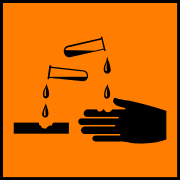|
Strong and weak acids and bases are characterised by their chemical and physical properties. |
|
Concentration
It is important to understand, and differentiate between, the terms 'concentration' and 'strength' when referring to acids (or bases). Unfortunately, these two terms are often used interchangeably when dealing with acids and bases, leading to confusion.
The term ' Concentration' means the number of moles of a dissolved substance per litre (mol dm-3) of aqueous solution. It is a measure of the dilution of the acid (or base). A more concentrated solution contains more moles of solute.
A concentrated acid may be either weak or strong depending on its nature. Similarly, a strong acid may be concentrated or dilute, depending on the amount of water with which it is mixed.
|
Note: The term 'acid concentration' may cause confusion if there is more than one hydrogen atom which can be released from the acid molecule in solution. For example, a 1.0 mol dm-3 solution of sulfuric acid (H2SO4) actually has a hydrogen ion concentration of greater than 1.0 mol dm-3, as there are two ionisations that take place:
The second ionisation does not go 100% to the right hand side, so the molarity of the hydrogen ions lies somewhere between the molarity of the sulfuric acid and 2 x the molarity of the sulfuric acid. |
The term 'concentrated' may also be used to indicate acid that has a high a molarity as feasibly possible. Approximate values are shown below for the concentrations normally commercially available. The percentage values are in weight/volume (w/v):
| Concentrated Reagents |
Density g/cm3 |
Molarity (M) |
Volume in cm3 required to make 1dm3 of 1M solution |
| Ethanoic acid - 99.5% | 1.05 | 17.4 | 57.5 |
| Hydrochloric acid - 36% | 1.18 | 11.65 | 85.8 |
| Hydrochloric acid - 32% | 1.16 | 10.2 | 98.0 |
| Hydrofluoric acid - 40% | 1.13 | 22.6 | 44.2 |
| Nitric acid - 70% | 1.42 | 15.8 | 63.3 |
| sulfuric acid 98% | 1.84 | 18.4 | 54.3 |
Strength
'Strength' refers to the degree of ionisation or dissociation of the acid or base.
Acidity is caused by the presence of hydrogen ions in the solution. If ANY acid has a high concentration then this will consequently increase the hydrogen ion concentration making the acid 'stronger'. When chemists refer to strong and weak acids they are referring to the degree with which the acid molecules break apart to give ions in aqueous solution (dissociation).
A strong acid, when placed in water, will ionise/dissociate virtually 100%, producing H3O+ ions from water.
Strong acid
|
HCl + H2O
|
H3O+(aq) + Cl-(aq)
|
|
|
0%
|
100%
|
A weak acid will, however, only partially dissociate into ions, leaving a high percentage of unreacted molecules in the solution. An equilibrium is established, and so when some of the H3O+ ions produced by a weak acid react, Le Chatelier's principle means that more of the acid will react to form H3O+ ions.
This means that, given an equal number of moles of acid, they will be neutralized by the same amount of strong base, but their solutions will have different concentrations of H+ ions and hence different pH values.
Weak acid
|
CH3COOH + H2O
|
H+(aq) + CH3COO-(aq)
|
|
|
approx 99%
|
approx 1%
|
Bases
A strong base dissociates 100% in solution releasing OH- ions.
Sodium hydroxide
|
NaOH + H2O
|
Na+(aq) + OH-(aq)
|
|
|
0%
|
100%
|
A weak base accepts protons (hydrogen ions) from the water and in doing so leaves some free OH- ions in solution. The stronger the base the higher the concentration of free hydroxide ions in the solution.
Ammonia
|
NH3 + H2O
|
NH4+(aq) + OH-(aq)
|
|
|
> 99%
|
< 1%
|
Neutralisation
Strong acids dissociate 100% into ions in solution, whereas weak acids only partially dissociate into ions. This does not however mean that weak acids fail to react fully with bases. Le Chatelier's principle tells us that if we remove one of the components from one side of an equilibrium, the equilibrium responds by making more.
Question How is the equation for a neutralisation reaction affected by the degree of dissociation of the acid or the base?
The stoichiometry of any reaction is unaffected by the strength of the acid or base.
For example the reaction of ethanoic acid with sodium hydroxide.
| CH3COOH + NaOH → CH3COONa + H2O |
Sodium hydroxide reacts with the available hydrogen ions removing them from the right hand side of the ethanoic acid equilibrium below:
CH3COOH  CH3COO- + H+
CH3COO- + H+ |
and
| NaOH + H+ → Na+ + H2O |
The equilibrium then responds by dissociating more ethanoic acid molecules to make more hydrogen ions. These then react with the sodium hydroxide and get removed from the equilibrium. The equilibrium makes more hydrogen ions by dissociating even more ethanoic acid, and so on until all the ethanoic acid has been neutralised by the sodium hydroxide.
The net result is that all the ethanoic acid reacts with the sodium hydroxide (if there is enough sodium hydroxide).


